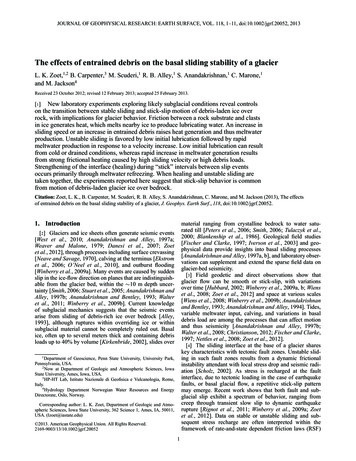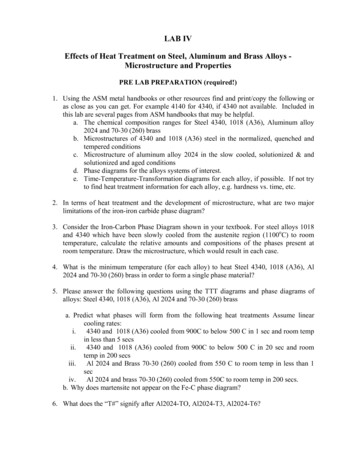
Transcription
LAB IVEffects of Heat Treatment on Steel, Aluminum and Brass Alloys Microstructure and PropertiesPRE LAB PREPARATION (required!)1. Using the ASM metal handbooks or other resources find and print/copy the following oras close as you can get. For example 4140 for 4340, if 4340 not available. Included inthis lab are several pages from ASM handbooks that may be helpful.a. The chemical composition ranges for Steel 4340, 1018 (A36), Aluminum alloy2024 and 70-30 (260) brassb. Microstructures of 4340 and 1018 (A36) steel in the normalized, quenched andtempered conditionsc. Microstructure of aluminum alloy 2024 in the slow cooled, solutionized & andsolutionized and aged conditionsd. Phase diagrams for the alloys systems of interest.e. Time-Temperature-Transformation diagrams for each alloy, if possible. If not tryto find heat treatment information for each alloy, e.g. hardness vs. time, etc.2. In terms of heat treatment and the development of microstructure, what are two majorlimitations of the iron-iron carbide phase diagram?3. Consider the Iron-Carbon Phase Diagram shown in your textbook. For steel alloys 1018and 4340 which have been slowly cooled from the austenite region (1100oC) to roomtemperature, calculate the relative amounts and compositions of the phases present atroom temperature. Draw the microstructure, which would result in each case.4. What is the minimum temperature (for each alloy) to heat Steel 4340, 1018 (A36), Al2024 and 70-30 (260) brass in order to form a single phase material?5. Please answer the following questions using the TTT diagrams and phase diagrams ofalloys: Steel 4340, 1018 (A36), Al 2024 and 70-30 (260) brassa. Predict what phases will form from the following heat treatments Assume linearcooling rates:i. 4340 and 1018 (A36) cooled from 900C to below 500 C in 1 sec and room tempin less than 5 secsii. 4340 and 1018 (A36) cooled from 900C to below 500 C in 20 sec and roomtemp in 200 secsiii. Al 2024 and Brass 70-30 (260) cooled from 550 C to room temp in less than 1seciv. Al 2024 and brass 70-30 (260) cooled from 550C to room temp in 200 secs.b. Why does martensite not appear on the Fe-C phase diagram?6. What does the “T#” signify after Al2024-TO, Al2024-T3, Al2024-T6?
Purpose: Understand the effect of cooling rates and reheating on microstructure and properties ofsteel, aluminum and brass alloys.To observe the heat treatment process for a 4340 and a 1018 (A36) steel sample andeffect on properties.To observe the heat treatment process for a 2024 aluminum sample and effect onproperties.To observe the effect of heat treatment on 260 Brass sample and effect on properties.Relate microstructure to mechanical propertiesHeat treatmentEach lab group will receive four alloys to test. We will be using 4340 and 1018 steel,2024 aluminum and 70-30 (260) brass. The steel samples will be austenitized at 900 degrees Cfor 30 minutes. The aluminum and brass samples will be heated to 550 C for 30 minutes. Thesamples will then be cooled in two manners. The first will be a slow air- cooling, which shouldresult in a piece approximately in equilibrium. The second piece will be quenched in waterresulting in a non-equilibrium sample. A subset of these samples will then be reheated totemperature that will allow limited diffusion for 30 minutes.Procedures:1. Wrap a piece of wire approximately 6 inches long around all samples. This will be usedto place and remove samples from furnaces.2. Heat the steel samples up to 900 C in furnace A. Heat the Aluminum and Brass samplesto 550 C in furnace B. Allow samples to equilibrate for approximately 30 minutes3. Cool the samples:a. Take the first two samples of EACH alloy and quench them in water. They mustbe removed from furnace and placed in the water very quickly, approximately 1-2seconds, so everything has to be ready.b. Remove second set of samples of each alloy and place in to bucket of vermiculite(an insulating material to slow cooling rate).4.Take 1 sample from each alloy and cooling rate and place in Furnace C for steel andFurnace D for Aluminum and Brass samples. Steels will be reheated to 300 C andaluminum and brass to 200 C for 30 minutes.
Sample 1Sample 2Sample 3Sample 4Steel 1018 (A36)Steel 4340Heat to 900Quench in H2OHeat to 900Quench in H2OReheat at 300 CHeat to 900Cool slowlyHeat to 900Cool slowlyReheat to 300 CHeat to 900Quench in H2OHeat to 900Quench in H2OReheat at 300 CHeat to 900Cool slowlyHeat to 900Cool slowlyReheat to 300 CAluminum 2024 70-30 (260)BrassHeat to 550 CHeat to 550 CQuench in H2O Quench in H2OHeat to 550CHeat to 550CQuench in H2O Quench in H2OReheat at 200 C Reheat at 200 CHeat to 550Heat to 550Cool slowlyCool slowlyHeat to 550Heat to 550Cool slowlyCool slowlyReheat to 200C Reheat to 200C5. Once the samples are cool they may have to be ground to remove the oxide layer(Steels!!). Do this using the belt sanders with water cooling.6. Take the hardness measurements using Rockwell C and/or Rockwell B scales. Take atleast 3 measurements on each sample and average the value. Be careful not to placeindents too close together as it may affect the results.7.Look at the microstructures of ALL samples at each of the four heat treatments. Polishedand etched samples of each type will be provided by the TA's. These samples werepolished to a 1 micron finish and then chemically etched to reveal the grain boundaries.View each of the samples, comment on the microstructures in your lab report and includemicrostructures at all heat treatments in your report. Compare the properties (hardness) ofALL alloys at after all heat treatments and explain in term of the phase transformations,resulting microstructure and easy of dislocation motion.Questions:1. What is the difference in 4340 steel vs 1018 (A36) steel.2. Which steel sample was harder, the air-cooled or water quenched? Why was it harder?3. Which steel alloy was harder? Why was it harder?4. How did the different cooling rate affect the microstructure of each steel? Do thesemicrostructures agree with what would be predicted from the TTT diagrams?5. What did reheating do to the steels (4340 and 1018 (A36)) microstructure and properties?Why?
6. Compare the TTT diagram for 1018 (A36) with that of 4340. What are the majordifferences? Why does the decomposition of austenite take longer in 4340 than 1018(A36)?7. What would be the effect of quenching in oil instead of water?8. What was the effect of reheating the samples:on microstructure and properties?9. What would happen to the microstructure and hardness if the samples were reheated to600C for 30 minutes and then quenched?10. For aluminum alloys, what do T0, T3 and T6 refer to? Did you treat Al 2024 to any ofthose conditions?11. Compare the hardness values you measured for each alloy in each condition with valuesfrom the literature. If there are any significant deviations from expected values, providelikely causes for this and how could it be corrected.Lab ReportThe lab report should address all the questions above but should not consist only of thesequestions. Please follow the procedures outlined on the homepage and in the lab. Look underlab handouts and report formats (How to write a lab report) for point distribution andrequirements. USESHORTLABFORMATReferences:1. William D. Callister, Jr., “Materials Science and Engineering an Introduction”, 6thEdition, John Wiley and Sons, New York. (2000), chap. 10-11.2. E.C. Subbarao, et al., "Experiments in Materials Science," McGraw-Hill, New Your,(1972).3. George L. Kehl, "The Principles of Metallographic Laboratory Practice," 3rd ed.,McGraw-Hill, New York (1949) 232-240.4. L. Van Vlack, "Elements of Material Science and Engineering," 6th ed., Addison Wesley,Reading, MA (1986) pp. 257-262, 292-304.5. R.E. Smallman, "Modern Physical Metallurgy," 4th ed., Butterworths, London, (1985)335-379.6. ASM Metals Handbooks
APPENDIX: Possibly useful diagrams and microstructures from Metals Handbook 8th edition,vol. 7, Atlas of time-temperature diagrams for nonferrous alloys / edited by George F.Vander Voort: ASM International, c1991 and Atlas of time-temperature diagrams for ironsand steels / edited by George F. Vander Voort: ASM International, c1991
LAB IV Effects of Heat Treatment on Steel, Aluminum and Brass Alloys - Microstructure and Properties PRE LAB PREPARATION (required!) 1. Using the ASM metal handbooks or other resources find and print/copy the following or as close as you can get. For example 4140 for 4340, if 4340 not available. Included in this lab are several pages from ASM handbooks that may be helpful. a. The chemical .

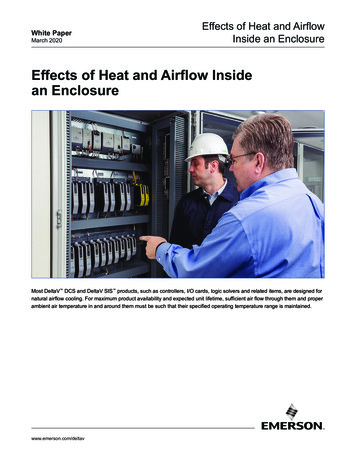
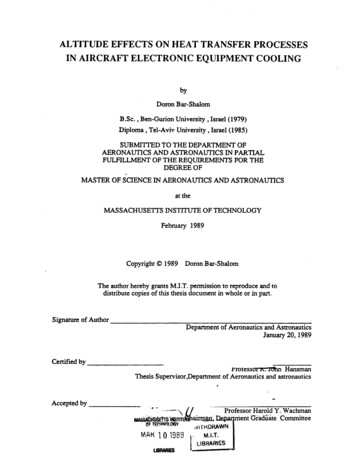
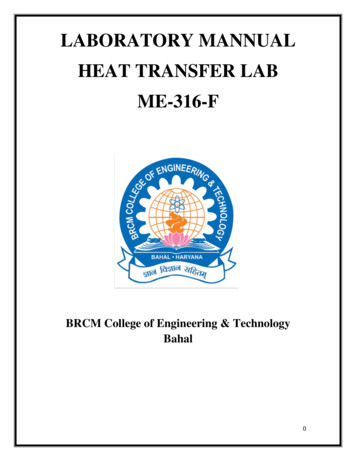
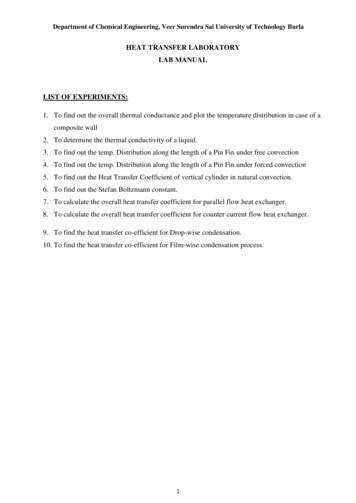
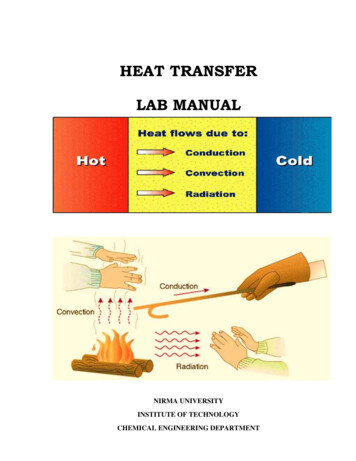
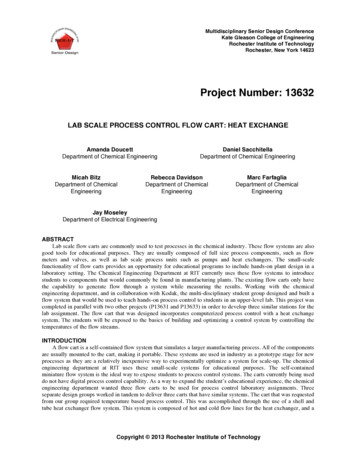
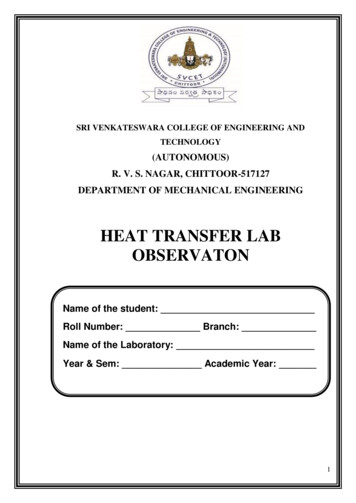


![[digital] Visual Effects and Compositing](/img/1/9780321984388.jpg)
